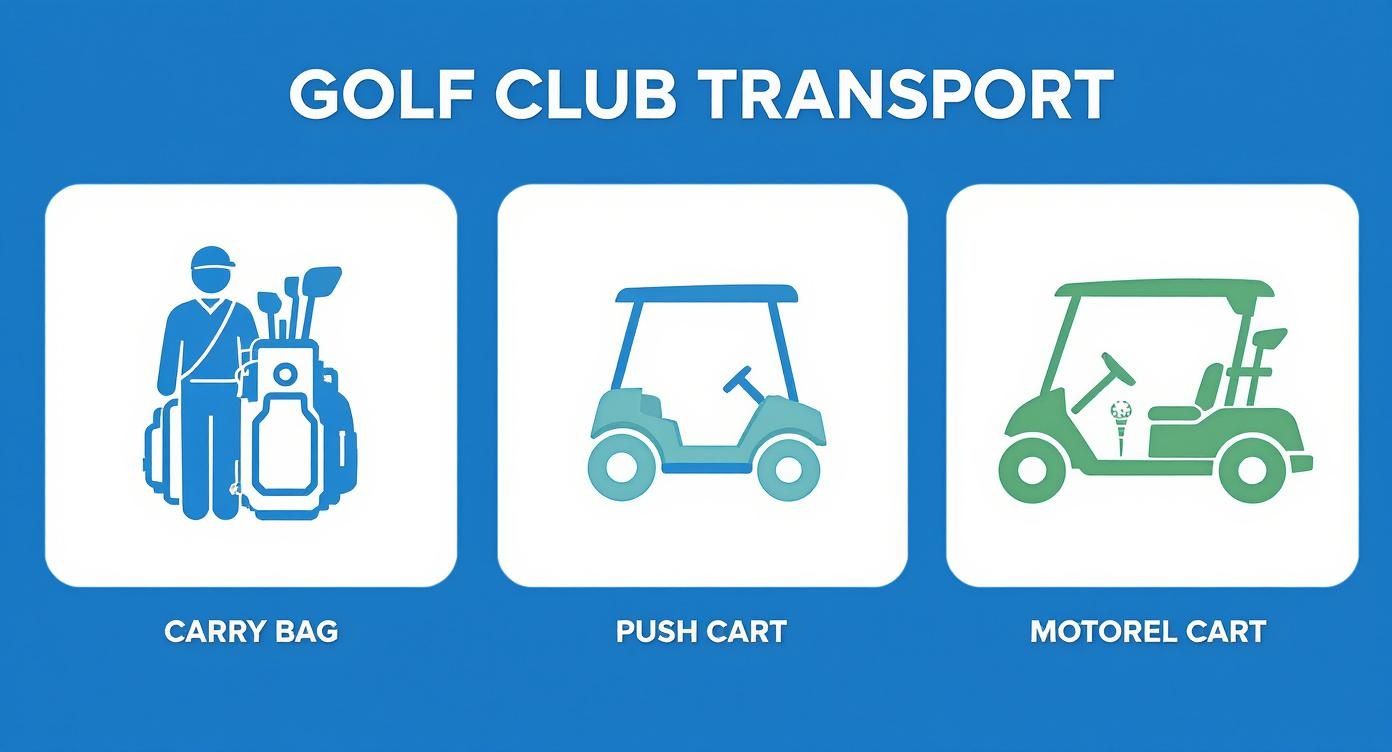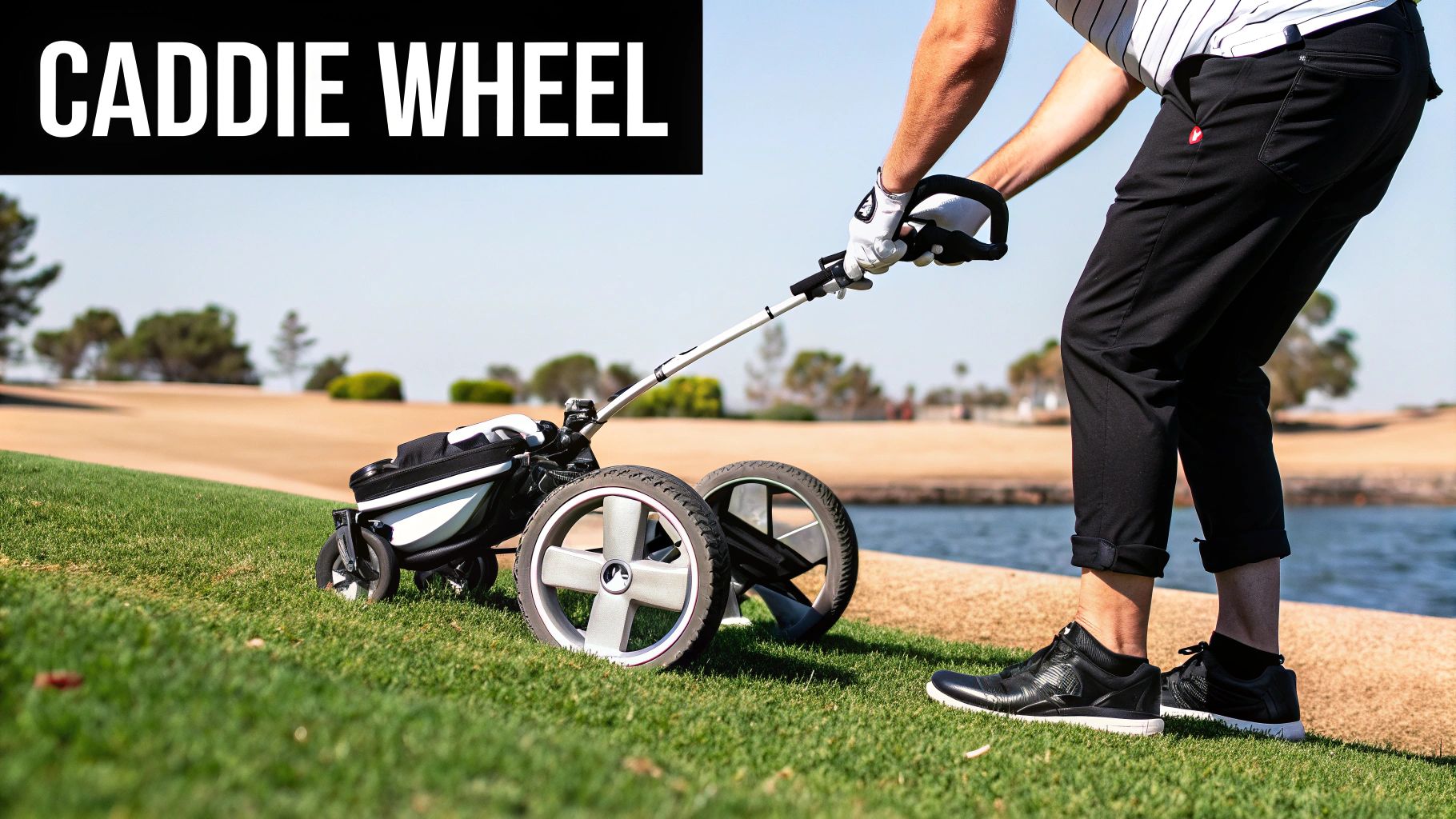Think of a golf push cart as your personal caddie on wheels. Its whole job is to carry your heavy bag so you can actually enjoy walking the course instead of feeling like you're training for a marathon. It’s the perfect middle ground between carrying your own clubs and renting a pricey motorized cart, giving you the best of both worlds—you get your exercise in without draining all your energy.
Decoding the Golf Push Cart
At its core, a push cart is a brilliantly simple solution to a very common problem: golf bags are heavy. Walking 18 holes can be a four- to five-mile trek, and when you’re lugging a 30-pound bag on your shoulders, that walk can turn into a grind. A push cart takes that entire burden off your back and shoulders.
That simple change has a massive ripple effect on your game. Instead of hitting the wall on the back nine, you’ll show up to each shot with more physical energy and a clearer head. It frees you up to focus on what actually matters—your next swing.
Why Choose a Push Cart?
So, where does a push cart fit into the grand scheme of getting your clubs around the course? It occupies a sweet spot, offering some serious perks over both shouldering your bag and riding in a motorized cart.
- Saves Your Body: It completely eliminates the strain of carrying clubs, which means less risk of back, shoulder, and neck pain down the road.
- Boosts Focus and Stamina: By saving all that energy, you can stay sharp and physically ready through all 18 holes, not just the front nine.
- Connects You to the Course: Walking lets you really see the course, notice the subtle breaks in the green, and just enjoy the experience of being out there.
A push cart lets you walk the course the way it was meant to be played, but without the physical toll. It’s about enjoying the journey from tee to green, not just surviving it.
To really see the difference, let’s quickly compare the three main ways golfers get their clubs from one hole to the next.
Carrying Your Clubs: A Quick Comparison
It's helpful to see how these three methods stack up side-by-side. Each one has its place, but the differences in physical demand, cost, and overall experience are pretty stark.
| Method | Physical Strain | Cost Per Round | Course Engagement |
|---|---|---|---|
| Carry Bag | High | $0 | High |
| Push Cart | Low | $0 (after initial purchase) | High |
| Motorized Cart | Very Low | $20 - $30+ | Low |
Looking at the table, it's clear the push cart offers a fantastic balance. You get all the benefits of walking the course without the high physical strain of carrying, and you save a bundle compared to renting a motorized cart every round.
Breaking Down the Modern Push Cart
Today's golf push cart is a far cry from a simple frame with wheels. It's a sophisticated piece of gear, cleverly engineered to make your round as smooth as possible so you can focus on the game, not the grunt work.
The heart of any good cart is its frame. Most are built from lightweight yet tough materials like aircraft-grade aluminum, which keeps the total weight under 20 pounds. This sturdy foundation supports the cart's wheel setup—and you've got options here. Three-wheel designs are famously nimble and great for making tight turns, while four-wheelers deliver unmatched stability, especially on hilly or uneven ground.
Regardless of the number, the wheels themselves are typically airless and designed for low rolling resistance. This means they glide effortlessly over fairways and even through the rough.
To see where the push cart fits in, this graphic breaks down the common ways golfers get their clubs around the course.

As you can see, the push cart hits that sweet spot—it gives you the physical engagement of walking without the strain of carrying, striking a perfect balance.
Key Features That Define a Good Cart
Beyond the basics, a few key features are what separate a truly great push cart from just an average one. An ergonomic, adjustable handle is a must, allowing golfers of any height to walk comfortably without slouching or straining. Right at your fingertips, you'll find the console, which is basically your on-course command center.
Think of the console as the dashboard of your cart. It’s designed to keep your most-used items—scorecard, phone, balls, and tees—organized and within arm's reach at all times.
Finally, a reliable braking system is non-negotiable, particularly if your home course has any elevation changes. Most carts will have either a hand brake conveniently located by the handle or a simple foot brake down by the rear wheels. All these components work in harmony to turn a simple cart into an indispensable tool for any walking golfer.
Manual Carts vs Electric Caddies
When you’re looking at golf push carts, one of the first big decisions is whether to stick with a classic manual model or go for its high-tech sibling, the electric caddie. It's a fundamental choice that shapes how you experience your walk around the course.
Think of a manual cart like a trusty, reliable station wagon—it’s simple, gets the job done without any fuss, and you’re in complete control. You provide all the power, pushing it from tee to green. It's straightforward and dependable.
Electric caddies, on the other hand, are the upgrade to a luxury SUV with all the bells and whistles. They come equipped with a motor and battery, taking the physical push out of the equation entirely. Many even come with slick features like remote controls or "follow-me" tech, where the cart just tags along behind you down the fairway.
Choosing Your Power Source
So, which one is right for you? It really boils down to your priorities on the course, your budget, and the kind of tracks you play. A manual cart is a fantastic choice for golfers who want a low-maintenance, grab-and-go option that’s always ready for a round.
An electric caddie is a game-changer for players who want to save every bit of energy for their swing. This is especially true on hilly courses, where even pushing a manual cart can start to feel like a real workout by the back nine. If you're leaning this way, our in-depth guide covers everything you need to know before buying an electric golf push cart.
The choice between manual and electric isn't just about effort—it's about how you want to experience your round. Do you prefer the simple engagement of pushing, or the effortless freedom of a fully automated caddie?
More and more golfers are opting for these feature-rich caddies, and it’s driving some serious market trends. The global golf push cart market was valued at around $250 million in 2025 and is expected to grow by 7% annually through 2033. A huge part of that growth is fueled by the demand for these technologically advanced electric models.
To make the decision a little easier, here's a direct comparison of what each type brings to the table.
Manual Push Cart vs Electric Push Cart
| Feature | Manual Push Cart | Electric Push Cart |
|---|---|---|
| Effort Required | You provide 100% of the power by pushing. | Minimal to zero; the motor handles the work. |
| Cost | Generally more affordable and budget-friendly. | Higher initial investment due to technology. |
| Weight | Lighter and easier to lift into a car or locker. | Heavier due to the battery and motor. |
| Maintenance | Very low maintenance—just keep it clean. | Requires battery charging and occasional upkeep. |
| Best For | Flat courses, budget-conscious golfers, exercise. | Hilly courses, energy conservation, tech enthusiasts. |
| Features | Basic features like storage and brake systems. | Advanced options like remote control, "follow" mode. |
Ultimately, both carts get your clubs from point A to point B. The real question is how much energy you want to spend getting them there. Whether you prefer the classic simplicity of a manual cart or the modern convenience of an electric one, the right choice is the one that lets you enjoy your game the most.
The Real Benefits of Walking With a Cart
Choosing to walk with a push cart is about so much more than just saving your shoulders from the strain of a heavy bag. This simple switch unlocks some surprising advantages that can genuinely improve your game, your health, and your overall enjoyment of a round.
The most immediate benefit? A massive reduction in physical fatigue.
Walking four to five miles is already a solid workout, but hauling a 30-pound bag on your back while you do it can drain your energy fast. By letting the cart do the heavy lifting, you save all that energy for what really matters: your swing. This means you’ll feel just as fresh and focused on the 18th tee as you did on the first, leading to smarter decisions and fewer mistakes late in the round.

This simple act of avoiding heavy loads is also a smart long-term investment in your physical well-being. Beyond the immediate convenience, walking with a push cart can seriously help your health by reducing strain, a principle that echoes the importance of safe lifting techniques for back protection.
Financial and Practical Perks
The advantages don't stop at the physical, either. From a financial standpoint, owning a push cart is a no-brainer. After the initial purchase, your cost per round drops to zero, saving you $20 to $30 every single time you play compared to renting a motorized cart. Over a season, those savings really start to add up.
A push cart pays for itself in just a few rounds. More importantly, it gives you the freedom to walk the course on your terms, connecting you more deeply with the game's rhythm and strategy.
Finally, there’s the sheer convenience factor. A modern push cart keeps everything you need perfectly organized and right at your fingertips. Your scorecard, drinks, rangefinder, and extra balls are all sitting there in the console, which means no more annoying searches through your bag between shots.
To dig deeper into these advantages, check out our guide on the top benefits of walking the golf course. This blend of improved performance, cost savings, and simple practicality makes it a game-changing addition for any golfer.
How the Caddie Wheel Is Changing the Game
What if you could get all the perks of a high-end electric caddie without having to shell out for a brand-new, expensive cart? That’s the exact question driving a major shift in golf gear, and the answer is a brilliant solution that upgrades the classic push cart you probably already own.

The Caddie Wheel is a smart conversion kit that transforms just about any manual push cart into a fully remote-controlled powerhouse. It neatly bridges the gap between old-school manual effort and modern automated convenience, offering a super practical and affordable way to an easier round of golf.
The Smart Upgrade for Your Existing Cart
The idea behind it is beautifully simple: instead of replacing your trusty cart, you supercharge it. The Caddie Wheel attaches a motorized wheel to your current setup, putting complete remote control right in the palm of your hand. This approach has a few key advantages:
- Affordability: It costs a whole lot less than buying a new, top-of-the-line electric caddie from scratch.
- Simple Installation: The design is made for a quick and easy attachment, getting you out on the course without any complicated setups.
- Universal Compatibility: It’s engineered to work with the vast majority of three and four-wheel push carts out there.
This system is a true game-changer for golfers who love their current cart but find themselves wishing for a little extra help on those long walks or hilly courses.
The Caddie Wheel is for the golfer who wants modern convenience without abandoning the equipment they already know and trust. It’s an upgrade, not a replacement.
While "push cart" makes us think of golf, the basic concept is a vital tool all over the world. Push cart vendors, for example, are crucial to local economies in places like Erode District, India, where many of the operators are over 50. This just goes to show how simple, wheeled assistance makes physically demanding work more sustainable for an older demographic—a principle that applies directly to the golf course.
This conversion kit makes the Caddie Wheel a fantastic solution for any golfer looking for an affordable electric caddie. To see how it stacks up against other big names in the industry, check out our analysis of the Caddie Wheel as the best Alphard Golf alternative.
Your Top Push Cart Questions Answered
Even after seeing all the benefits laid out, you probably have a few practical questions about what it’s like to actually own and use a push cart. Let's tackle some of the most common ones to clear up any lingering doubts.
How Much Does a Push Cart Cost?
The price tag on a new push cart can vary quite a bit, really depending on whether you’re looking at a manual or electric model.
- Manual Push Carts: You’ll find plenty of solid, well-built manual carts in the $150 to $300 range. Models in this sweet spot usually have lightweight aluminum frames, fold up easily, and come with all the essential storage you need.
- Electric Caddies: If you want a fully electric caddie, the investment is a lot bigger. They typically start around $800 and can easily soar past $2,000 for high-end versions with fancy remote controls and follow-me tech.
This is exactly where a conversion kit like the Caddie Wheel finds its niche. It gives you that electric boost for a fraction of what a brand-new electric model would cost.
Are Push Carts Allowed on All Golf Courses?
Almost always, yes! The vast majority of courses don't just allow push carts; they actually encourage them. They’re a fantastic way to speed up play without causing the same wear and tear as a heavy, motorized golf cart.
That said, a handful of very exclusive or traditional clubs might have their own specific rules.
If you’re heading out to a new course, especially a private one, it's never a bad idea to make a quick call to the pro shop. Just ask about their policy on personal push carts to be safe.
What Is the Difference Between 3 and 4 Wheels?
Choosing between three and four wheels really comes down to what your home course is like.
- Three-Wheel Carts: These guys are known for being incredibly nimble. The single front wheel makes steering and navigating tight turns a breeze, which is perfect for flatter courses with well-defined paths.
- Four-Wheel Carts: With a wider base, these carts are all about stability. If you play on a hilly course or deal with a lot of uneven ground, a four-wheel model is far less likely to tip over and keeps your bag much more secure.
What Basic Maintenance Do They Need?
Honestly, one of the best things about a standard push cart is how little work it takes to maintain. A few simple habits will keep it rolling smoothly for years to come.
Just give the frame a quick wipe-down now and then to keep it clean, double-check that the brake is still engaging properly, and make sure the wheels aren't clogged with grass or dirt. That's pretty much all it takes to keep your cart in top shape, season after season.
Ready to transform your walk? The Caddie Wheel offers an effortless, powerful, and affordable upgrade to the push cart you already own. Experience the freedom of a remote-controlled caddie and save your energy for the game. Learn more and upgrade your round today!


Share:
Your Guide to Replacement Lithium Battery Success
The Ultimate Guide to Electric Golf Cart Bags